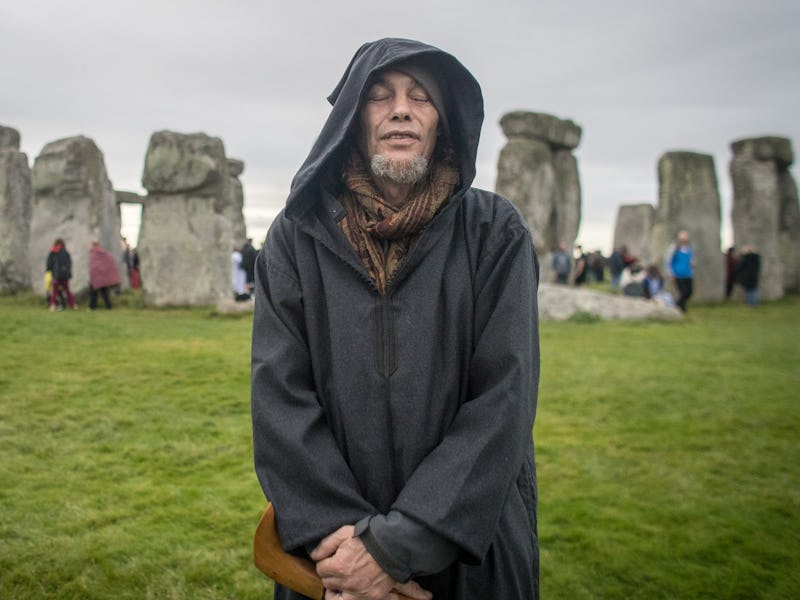5 Wild Facts About the Winter Solstice Tonight
We're turning a corner, people. Longer days ahead!

The winter solstice is upon us, which means the northern hemisphere can finally look forward to gradually lengthening days. That’s right, it may be dark now, but remember tonight, we turn the corner to gradually longer days. This year, the longest night of the year is tonight, Thursday, December 21, with the solstice — the exact moment fall gives way to winter — taking place at 11:28 a.m. Eastern on December 21.
While Western Christian societies might associate the holiday with the general Christmas season, pagan religions in Europe, Middle Eastern societies, and Native American cultures have celebrated the long night with feasts, drinking, sacrifice and all manner of revery and ritual for millennia. Here are some of the most interesting facts about the winter solstice.
You Might Also Like: Tonight’s Winter Solstice Is More Than the Longest Night of the Year
The solstice isn’t always on December 21
The winter solstice is actually a precise moment in time when the sun is directly over the Tropic of Capricorn. This year, that happens at 11:28 a.m. Eastern on December 21. But December 21 isn’t always when the solstice happens. Thanks to the Earth’s wobble, it varies a bit from year to year. The last time the solstice wasn’t on December 21 was back in 2011, when it fell on December 22. For much of the first half of the 20th century, December 22 was the date of the solstice, but December 20 will become the norm later this century, though the solstice won’t happen on December 20 until 2052. The wobble, known as axial precession, shifts the position of the north pole by about one degree every 72 years, shifting the solstice.
The solstice is caused by axial tilt from a giant planetary collision
Our planet is crooked. It tilts 23.5 degrees from vertical, to be exact. In fact, some astronomers think the planet’s tilt came from a massive collision that nearly vaporized the Earth and made part of it split off to become the moon. In the present day, a world without an axial tilt would be pretty boring. We wouldn’t have seasons, for starters. For part of the year, one side of the Earth spends more time pointed toward the sun, which is what we call summer. The days are longer and warmer. But for the opposite side, it’s winter, with its short, cold days. Whichever pole is away from the sun is plunged into total darkness for several months, while the opposite pole has days with nearly endless sunshine.
It’s one of the few times a year you can get up close to the rocks at Stonehenge
Stonehenge lets visitors walk among the stones during the winter and summer solstices, as well as the spring and autumn equinoxes.
English Heritage, the group that oversees Stonehenge, lets visitors freely walk through the ancient stone monument just four times a year — the two solstices and the two equinoxes.
The Earth's orbit is in no way a circle.
The Earth isn’t all that far from the Sun
While the frigid temperatures during the northern hemisphere’s winter might make it feel like we’re especially far from the Sun, the dead of winter in the Northern Hemisphere is actually when the Earth’s orbit gets closest to its star, a phenomenon known as “perihelion.” Perihelion typically happens a few weeks after the solstice, in early January, but the Earth is still pretty close to the Sun then.
A goat for sacrifice during Eid Al-Adha in Indonesia. Eid is NOT the same holiday as the Winter Solstice, but the cultural practice of ritual sacrifice is similar to that practiced by many European civilizations during Yule.
It’s a great night for blood sacrifice
In England, many families still celebrate Christmas with a Yule Ham, or Yule Boar. While the practice of eating a nice ham on Christmas might seem innocuous, the tradition dates back to the common ritual slaughter that Germanic other pagan societies had during the winter solstice. Pigs, goats, sheep, and other animals were sacrificed to the Germanic goddess Freyr in the hopes of a good harvest and fertility. When Christian envoys swept through Europe on the coattails of the Roman Empire, shrewd evangelical priests found ways to preserve local customs, like Yuletide or Solstice sacrifices, into the new lore of Christianity.
This article was originally published on December 20, 2016.